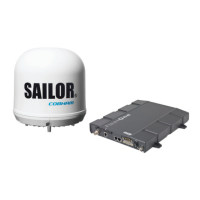Chapter 2: Installation
98-141368-A 8
Radiation hazard
The SAILOR Fleet One antenna radiates 16.1 dBW EIRP. This translates to a minimum safety
distance of 0.6 m from the antenna while it is transmitting, based on a radiation level of
10 mW/cm
2
.
Interference
The antenna must be mounted as far away as possible from the ship’s radar and high power
radio transmitters (including other Inmarsat based systems), because they may compromise
the antenna performance. RF emission from radars might actually damage the antenna.
The SAILOR Fleet One antenna itself may also interfere with other radio systems. Especially
other Inmarsat systems and GPS receivers with poor frequency discrimination are vulnerable
to the radiation generated by the SAILOR Fleet One antennas.
Radar
It is difficult to give exact guidelines for the minimum distance between a radar and the
antenna because radar power, radiation pattern, frequency and pulse length/shape vary from
radar to radar. Further, the antenna is typically placed in the near field of the radar antenna and
reflections from masts, decks and other items in the vicinity of the radar are different from ship
to ship.
However, it is possible to give a few guidelines:
Since a radar radiates a fan beam with a horizontal beam width of a few degrees and a vertical
beam width of up to +/- 15°, the worst interference can be avoided by mounting the antenna
at a different level – meaning that the antenna is installed minimum 15° above or below the
radar antenna. Due to near field effects the benefit of this vertical separation could be reduced
at short distances (below approximately 10 m) between radar antenna and the
SAILOR Fleet One antenna. Therefore it is recommended to ensure as much vertical separation
as possible when the SAILOR Fleet One antenna has to be placed close to a radar antenna.

